
KABO, REPUBLIC OF CONGO, 23 MAY 2021: An image of Baka pygmy expert bushmeat hunter walking with an antelope he has shot down a logging road in a timber concession bordering a national park in the Repulic of Congo. As part of a conservation project WCS and SWM work with a logging concession on three separate concessions. They allow their workers to hire these pygmies, who are excellent hunters, to hunt for them in controlled circumstances twice a month in a legal hunting area on the periphery of Nouama Ndoki National Park. Each hunter gets a rifle from the employee and 4 shotgun cartridges. They are only allowed to shoot that much, no more. They usually get to keep the entrails and a small payment. Many of these pygmies do also hunt independently but this collaboration with the logging concessions involves weighing and counting the animals too. It was conceived to prevent the workers from hunting on company time in company vehicles. The hunts are twice a month for the 6 month hunting season. (Photo by Brent Stirton/Getty Images for National Geographic.)

DOUME VILLAGE, CLOSE TO LASTOURSVILLE, GABON, 29 JUNE 2021: Expert bushmeat hunter Nkani Mbou Mboudin is seen with an antelope he just shot hunting in the forest around his village. This village survives on fishing and bushmeat. Gabon has a sustainable bushmeat culture, largely because of its small population and large protected habitats. (photo by Brent Stirton/Getty Images for FAO, CIFOR, CIRAD, WCS)

KABO, REPUBLIC OF CONGO, 23 MAY 2021: Jonas Manguba is seen with two of three monkeys he shot today. Jonas has hunted since he was a child with his father, today he shoot five monkeys on most of his hunts. Apart from the controlled hunt he was on today, he also hunts independently as a chief source of income. Jonas is a Baka pygmy bushmeat hunter. As part of a conservation project WCS and SWM work with a logging concession on three separate concessions. They allow their workers to hire these pygmies, who are excellent hunters, to hunt for them in controlled circumstances twice a month in a legal hunting area on the periphery of Nouama Ndoki National Park. Each hunter gets a rifle from the employee and 4 shotgun cartridges. They are only allowed to shoot that much, no more. They usually get to keep the entrails and a small payment. Many of these pygmies do also hunt independently but this collaboration with the logging concessions involves weighing and counting the animals too. It was conceived to prevent the workers from hunting on company time in company vehicles. The hunts are twice a month for the 6 month hunting season. (Photo by Brent Stirton/Getty Images for National Geographic.)

LEFONDO VILLAGE, BOENDE DISTRICT, TSHUPA PROVINCE, DEMOCRATIC REPUBLIC OF CONGO, 25 APRIL, 2021: Bushmeat hunter Arthur Bengo, 28, sits for a portrait in the early morning outside his village of Lefondo, about 30kms outside of Boende town. The scars on Arthurs face are what remains from an attack of monkeypox, a virulent zoonotic disease carried in certain monkeys and rodents that can be devastating when passed to humans. Arthur says he shot a monkey and noticed that it did not seem to be doing well. He ate a third of the primate and took the other two thirds back to his family. By the time he arrived he was not feeling well and advised his family to throw away the remains of the monkey. The next day Arthur started to see the tell-tale lessions that accompany Monkeypox appear on his body. He developed a high temperature, became very sensitive to noise and could not sleep for more than two months. The only relief he could get from the lessions was cool water and that was always very temporary. Arthur was fortunate that he recognized the signs of monkeypox and went to the nearest health center where he was immediately given penicillin. It took Arthur three months to recover but his scars are still evident. A number of people in his village die of monkeypox every year, it is particularly dangerous to young children who often do not survive. The more remote the village, the less the chances for people who contract Monkeypox. This can be very challenging in areas where food is scarce and eduction low. (Photo by Brent Stirton/National Geographic Magazine.)

KABO, REPUBLIC OF CONGO, 23 MAY 2021: An image of Henry, a Baka pygmy bushmeat hunter seen after a successful hunt. As part of a conservation project ngo's WCS and SWM work with a logging company on three separate concessions. They allow their workers to hire these pygmies, who are excellent hunters, to hunt for them in controlled circumstances twice a month in a legal hunting area on the periphery of Nouama Ndoki National Park. Each hunter gets a rifle from the employee and 4 shotgun cartridges. They are only allowed to shoot that much, no more. They usually get to keep the entrails and a small payment. Many of these pygmies do also hunt independently but this collaboration with the logging concessions involves weighing and counting the animals too. It was conceived to prevent the workers from hunting on company time in company vehicles. The hunts are twice a month for the 6 month hunting season.

VILLAGE NDAMBI, AREA OF LASTOURSVILLE, GABON, 30 JUNE 2021: Brenteh Ngogne and Davy Lindzondzo are bushmeat hunters , they are seen with the Duiker and Antelope they killed the previous night in the forest around the village of Ndambi, one of a number of villages in the area where SWM has relations and regular monitoring for bushmeat consumption. Rick is seen preparing to enter the forest for a night hunting expedition. Night hunting is controversial and there is talk of banning it in Gabon. (photo by Brent Stirton/Getty Images for FAO, CIFOR, CIRAD, WCS)

KABO, REPUBLIC OF CONGO, 23 MAY 2021: Images of Baka pygmy bushmeat hunters. As part of a conservation project WCS and SWM work with a logging concession on three separate concessions. They allow their workers to hire these pygmies, who are excellent hunters, to hunt for them in controlled circumstances twice a month in a legal hunting area on the periphery of Nouama Ndoki National Park. Each hunter gets a rifle from the employee and 4 shotgun cartridges. They are only allowed to shoot that much, no more. They usually get to keep the entrails and a small payment. Many of these pygmies do also hunt independently but this collaboration with the logging concessions involves weighing and counting the animals too. It was conceived to prevent the workers from hunting on company time in company vehicles. The hunts are twice a month for the 6 month hunting season. (Photo by Brent Stirton/Getty Images for National Geographic.)

RUPUNUNI RIVER, GUYANA: Herman Phillips, 63, has lived his whole life in the Rupununi region bases on a subsistence existence. He believes that is his natural right as an indigenous person in the Rupununi. He fishes using nets and lines and he hunts in the forest. This is how he has fed and clothed his 8 children and he would like to see that be an option for them too. Members of the Sustainable Wildlife Management Program, SWM, on a Rupununi River expedition with partners, the South Rupununi Conservation Society. This trip focused on fishing, bow-fishing and local hunting and lifestyles. It also took in the condition of the river and the sidecreeks employed by locals for food and shelter and occasional gold mining prospecting. In the Rupununi region, on Amerindian land, everything is ruled by the village and they control hunting and fishing. In the protected areas, the villages and government partner on these things. The Rupununi Region is located in the southwest of Guyana. It consists mostly of large tracts of primary forest, with about 20% of its land area covered by natural Neotropical savanna and seasonally flooded wetlands. The region has approximately 24,000 inhabitants, including indigenous groups that rely on subsistence hunting, fishing and farming. During recent years, fish populations have declined, and similar trends are being observed for terrestrial wildlife. Studies indicate that hunting-dependent livelihoods are sustainable within indigenous lands. Scenarios highlight the probability of future disruption due to infrastructure development, competition with other more lucrative land uses, climate change, and cultural transformation. While conservation efforts are evolving in the Rupununi, there is a need to foster long-term sustainable management practices. In addition, there is a need to share lessons learnt that may be valuable in other Caribbean and Amazonian countries. The SWM Guyana project is building upon existing strategies, visions and dev

VILLAGE NDAMBI, AREA OF LASTOURSVILLE, GABON, 30 JUNE 2021: Rick Lindzondzo is a talented bushmeat hunter , he is seen with the Duiker and Antelope he killed the previous night in the forest around the village of Ndambi, one of a number of villages in the area where SWM has relations and regular monitoring for bushmeat consumption. Night hunting is controversial and there is talk of banning it in Gabon. (photo by Brent Stirton/Getty Images for FAO, CIFOR, CIRAD, WCS)
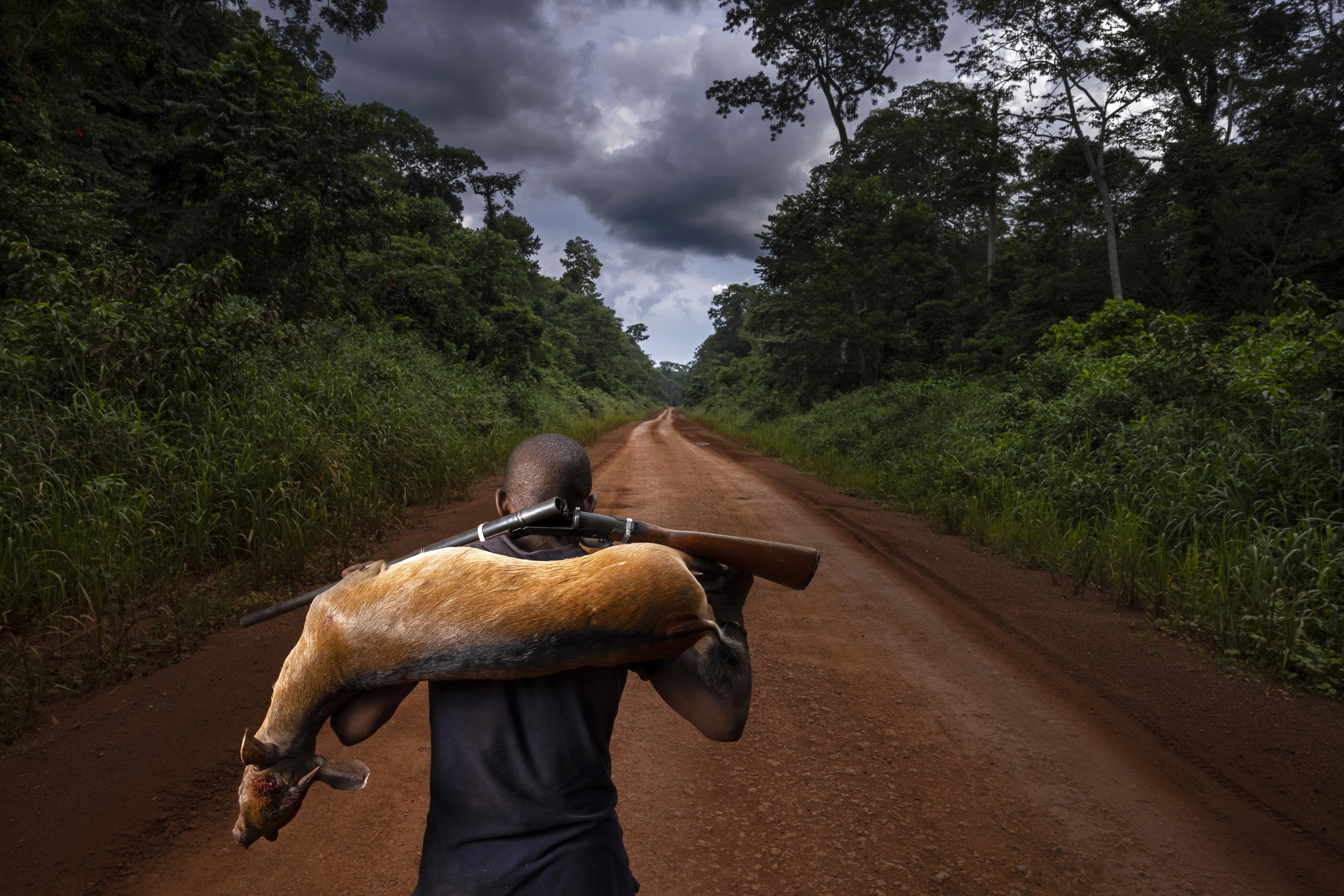
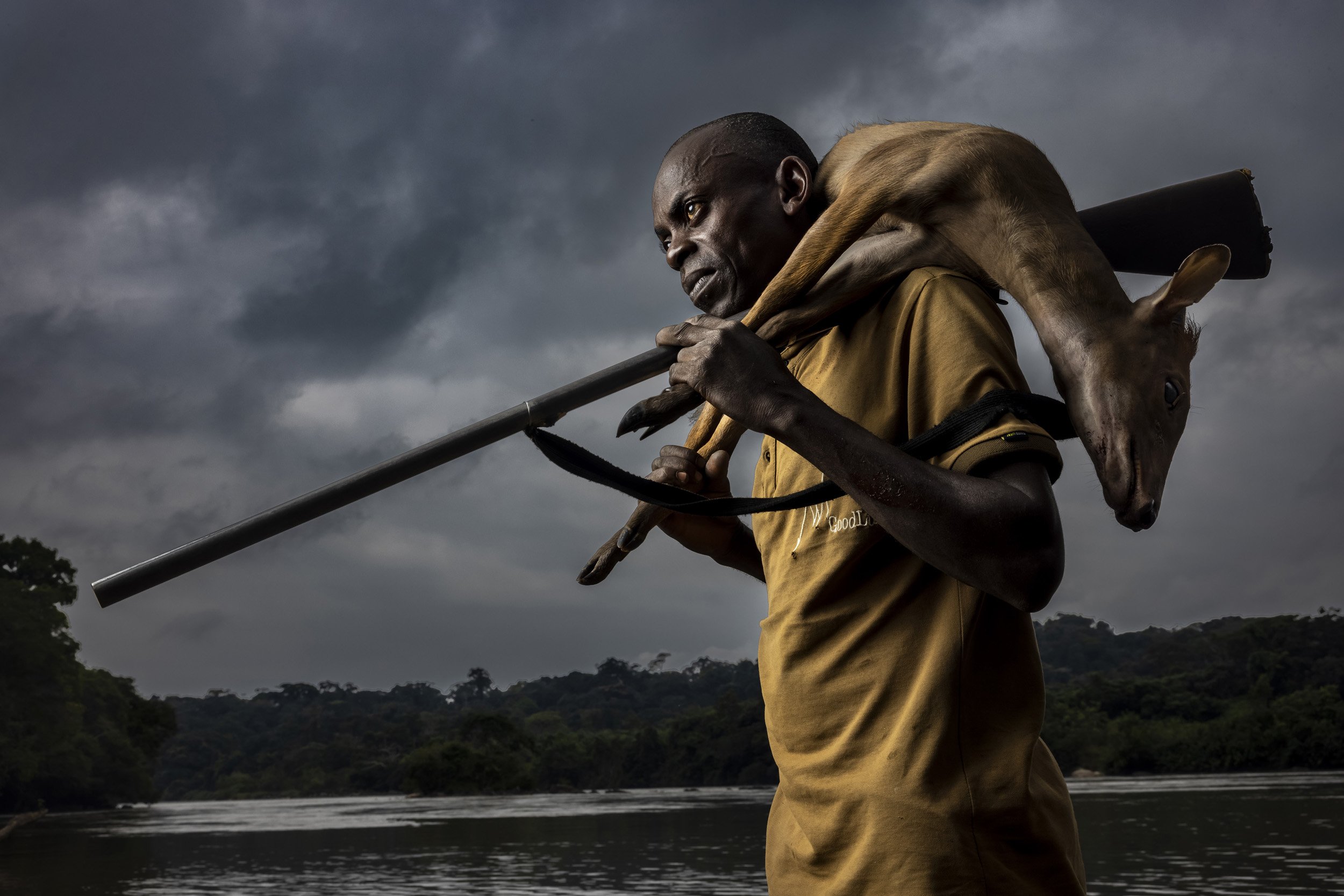
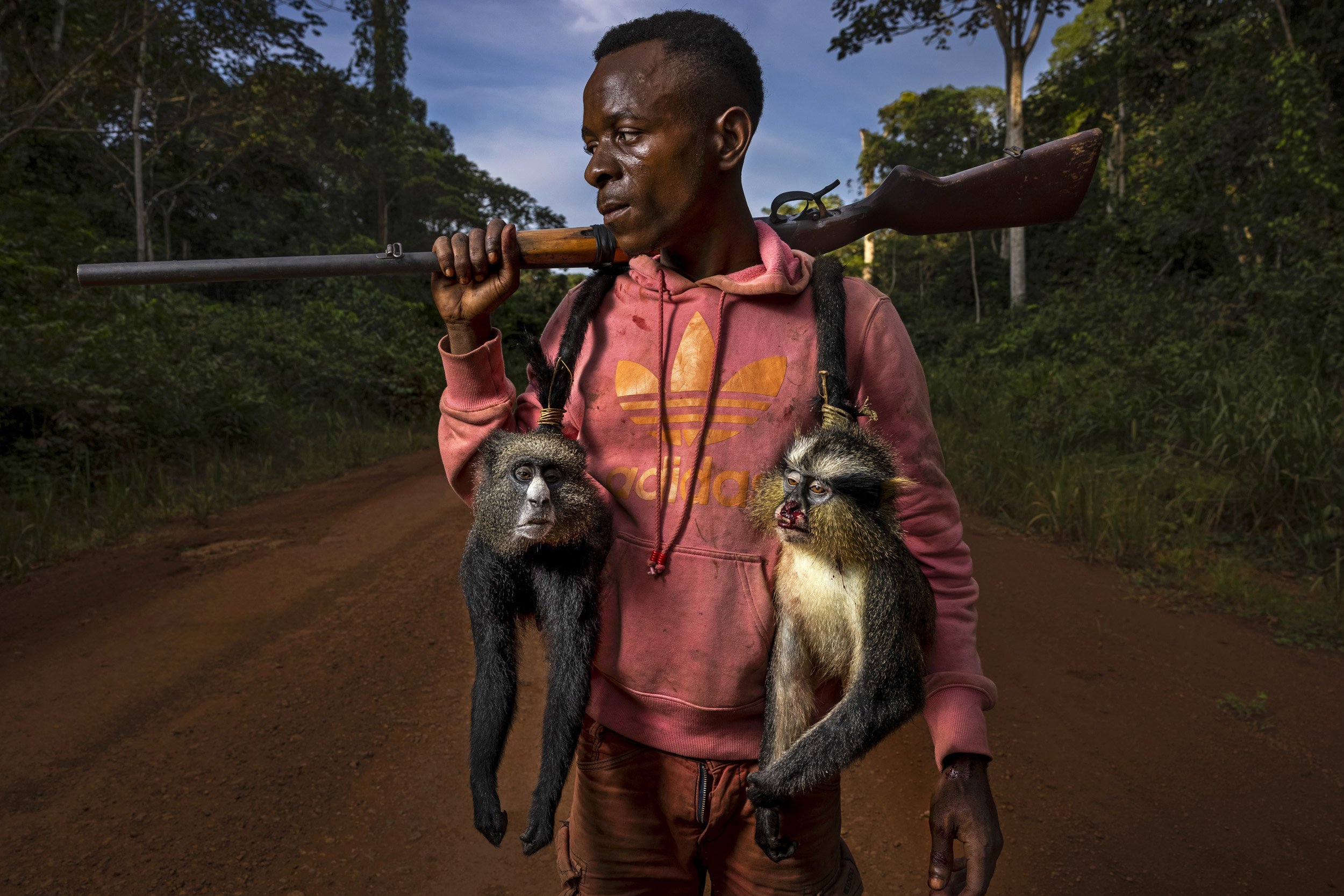
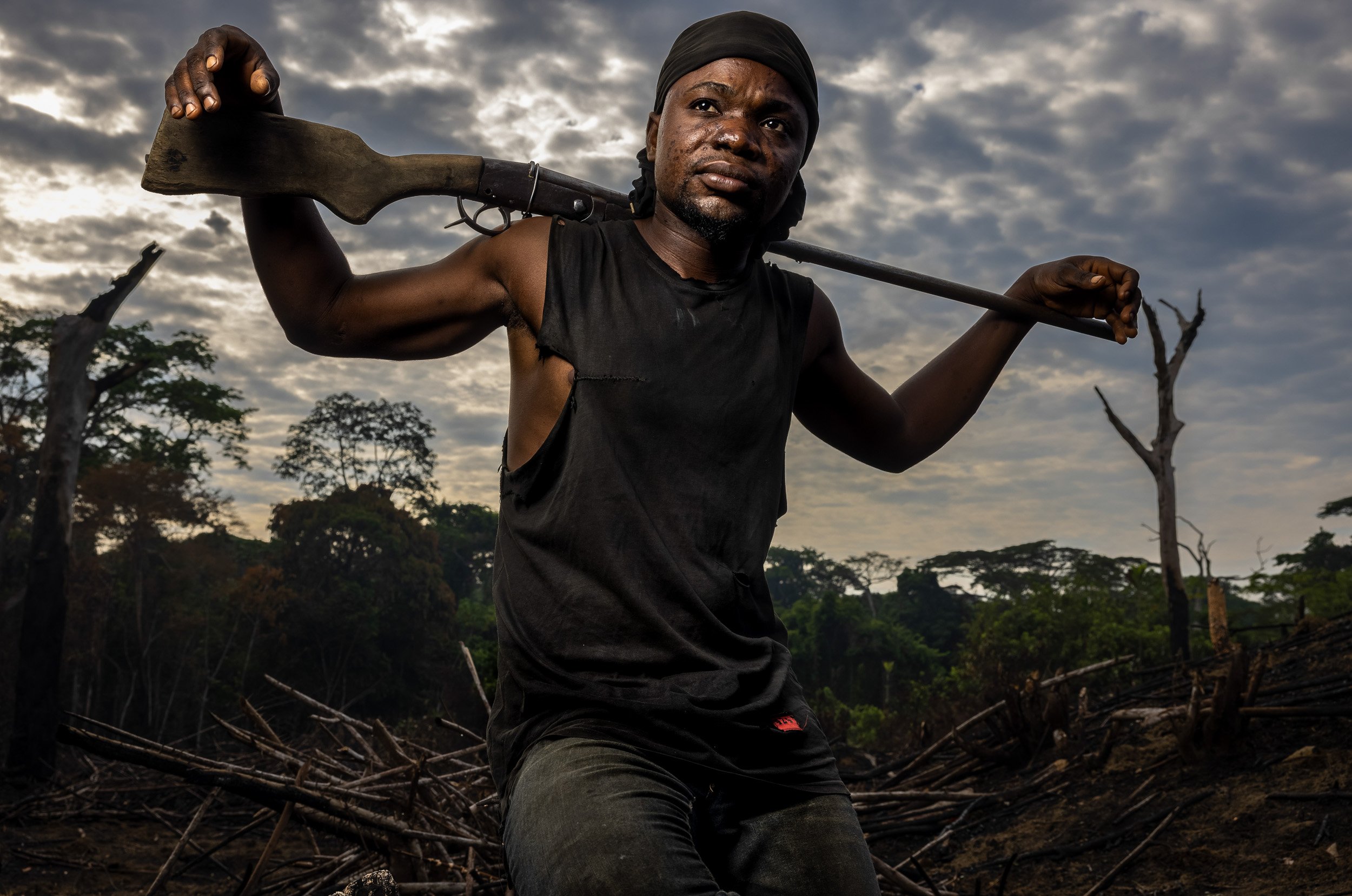
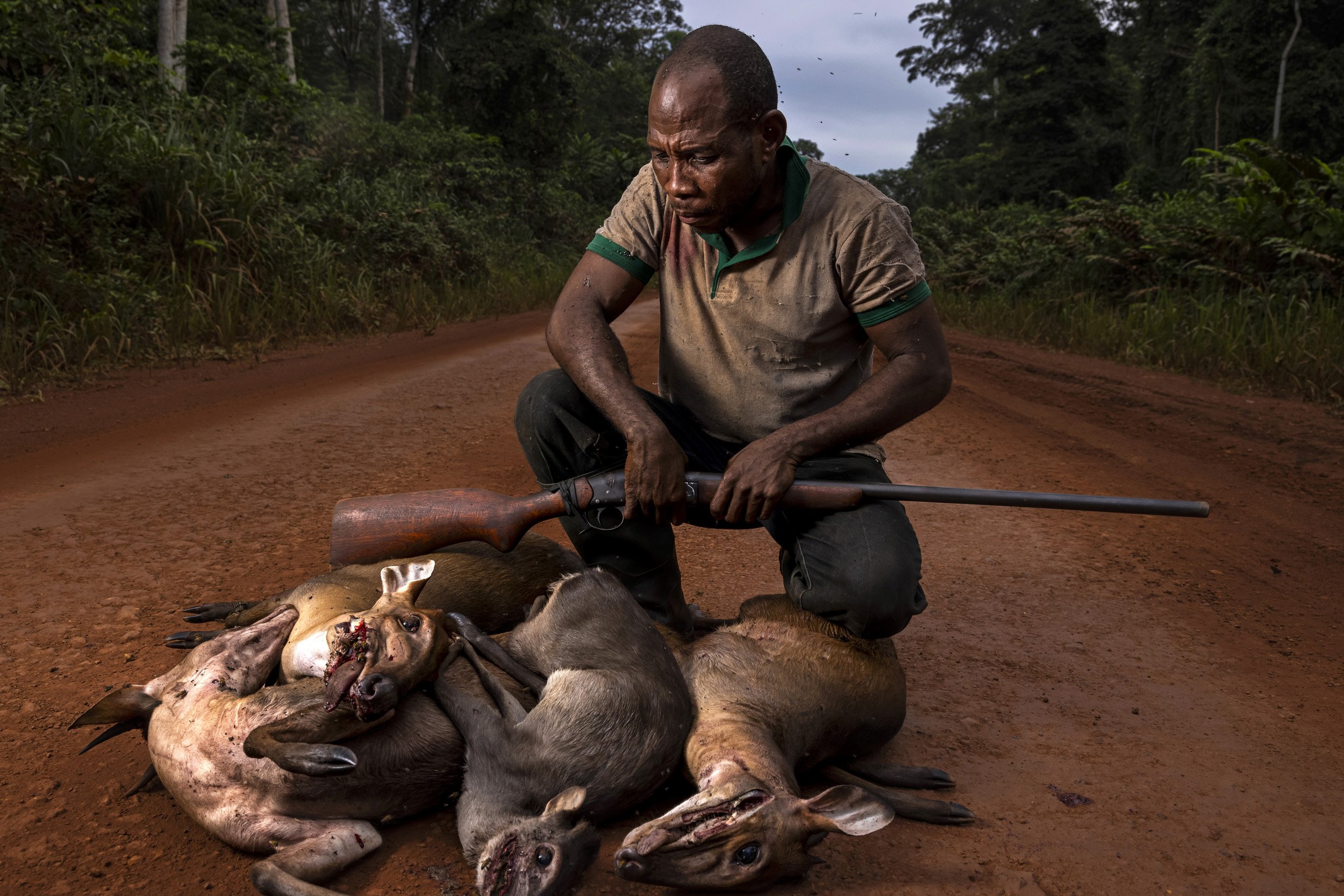
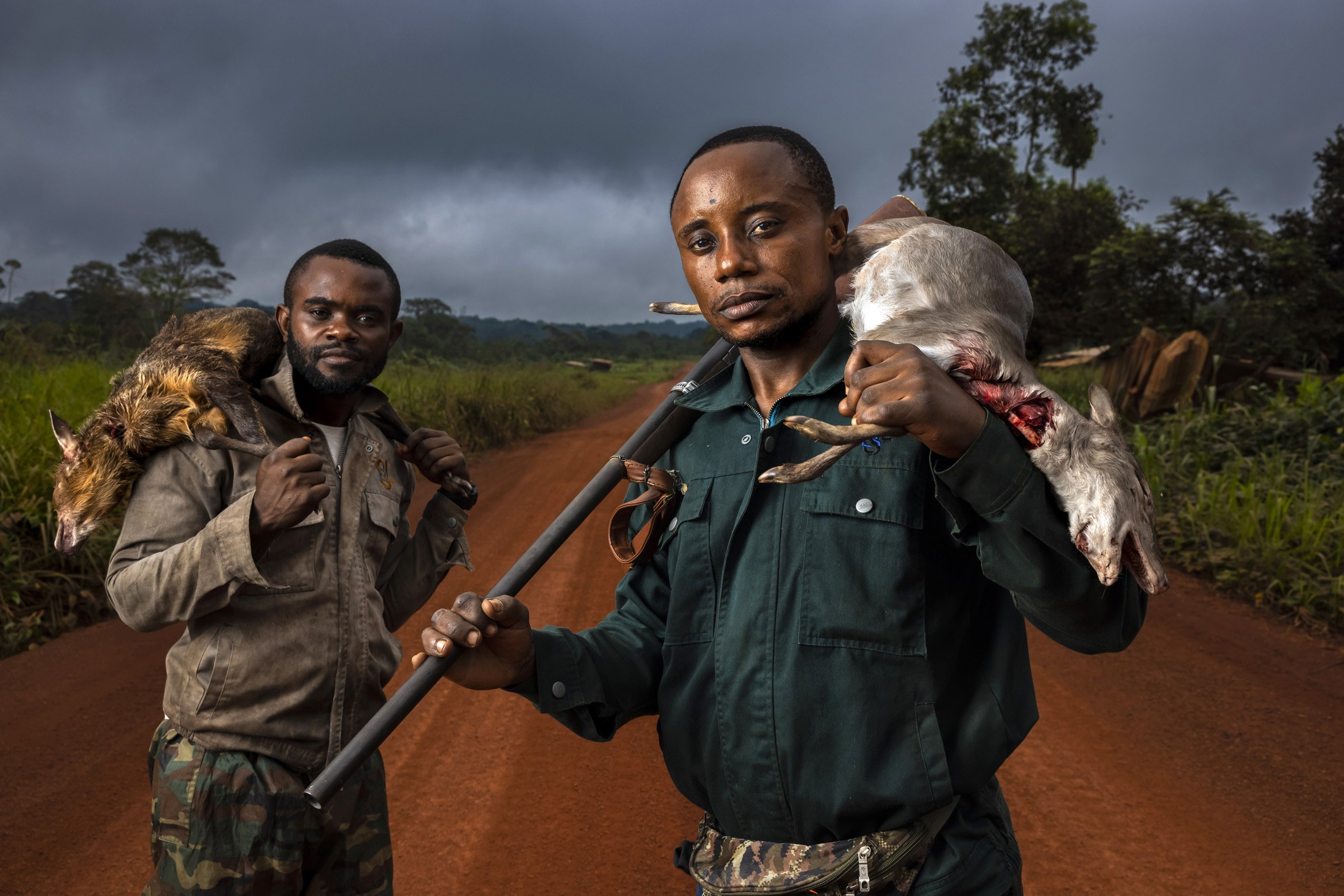

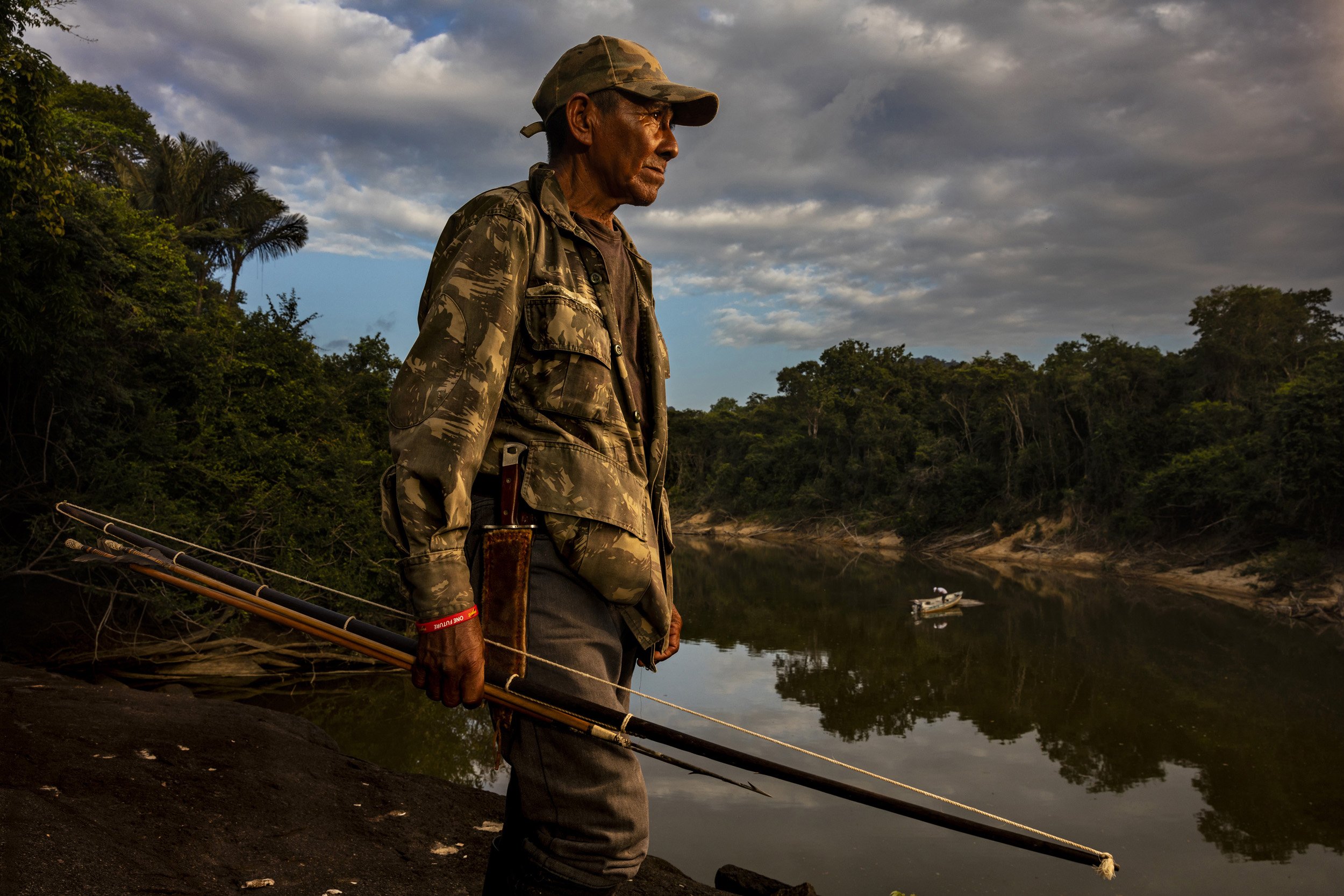
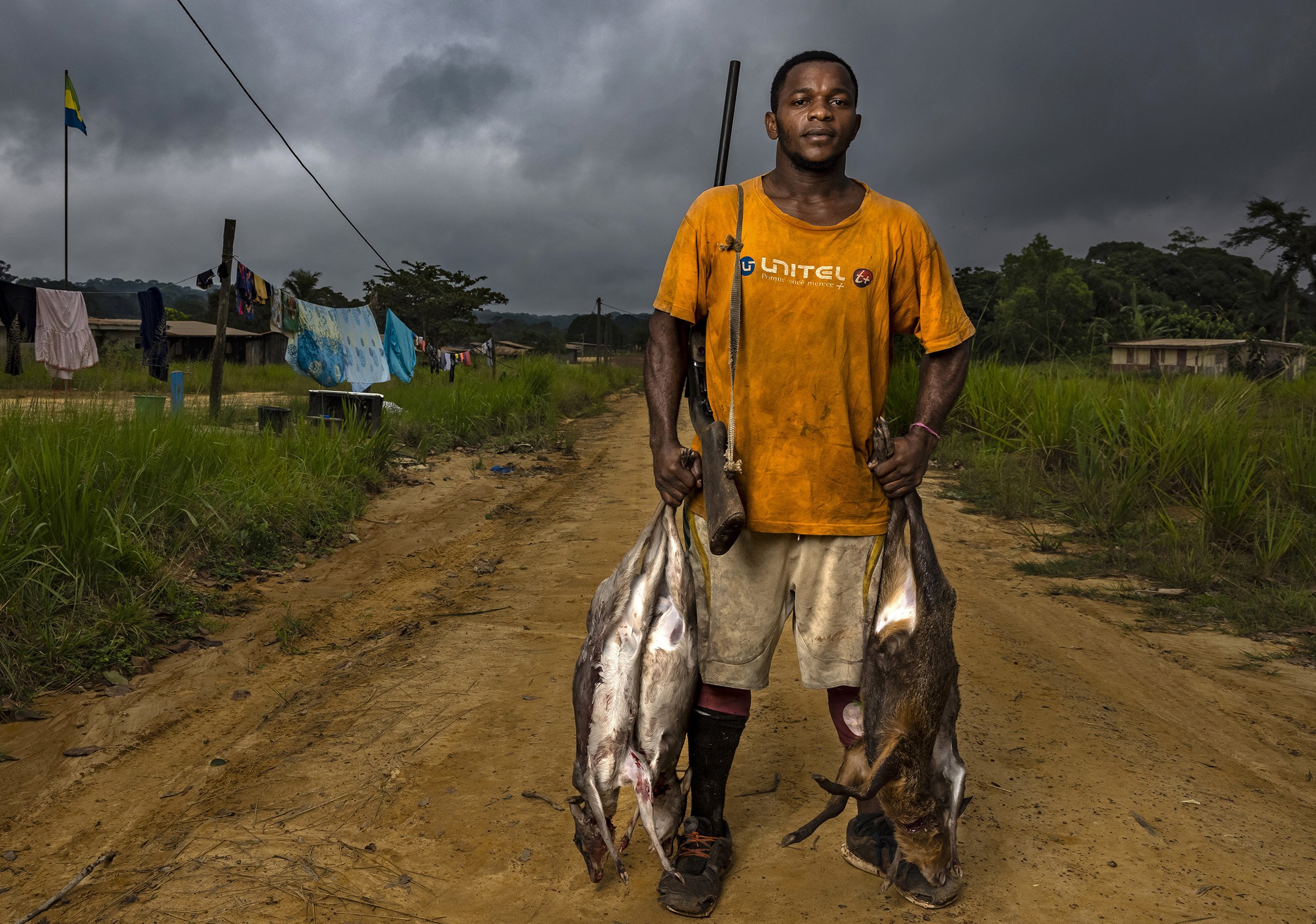
KABO, REPUBLIC OF CONGO, 23 MAY 2021: An image of Baka pygmy expert bushmeat hunter walking with an antelope he has shot down a logging road in a timber concession bordering a national park in the Repulic of Congo. As part of a conservation project WCS and SWM work with a logging concession on three separate concessions. They allow their workers to hire these pygmies, who are excellent hunters, to hunt for them in controlled circumstances twice a month in a legal hunting area on the periphery of Nouama Ndoki National Park. Each hunter gets a rifle from the employee and 4 shotgun cartridges. They are only allowed to shoot that much, no more. They usually get to keep the entrails and a small payment. Many of these pygmies do also hunt independently but this collaboration with the logging concessions involves weighing and counting the animals too. It was conceived to prevent the workers from hunting on company time in company vehicles. The hunts are twice a month for the 6 month hunting season. (Photo by Brent Stirton/Getty Images for National Geographic.)
DOUME VILLAGE, CLOSE TO LASTOURSVILLE, GABON, 29 JUNE 2021: Expert bushmeat hunter Nkani Mbou Mboudin is seen with an antelope he just shot hunting in the forest around his village. This village survives on fishing and bushmeat. Gabon has a sustainable bushmeat culture, largely because of its small population and large protected habitats. (photo by Brent Stirton/Getty Images for FAO, CIFOR, CIRAD, WCS)
KABO, REPUBLIC OF CONGO, 23 MAY 2021: Jonas Manguba is seen with two of three monkeys he shot today. Jonas has hunted since he was a child with his father, today he shoot five monkeys on most of his hunts. Apart from the controlled hunt he was on today, he also hunts independently as a chief source of income. Jonas is a Baka pygmy bushmeat hunter. As part of a conservation project WCS and SWM work with a logging concession on three separate concessions. They allow their workers to hire these pygmies, who are excellent hunters, to hunt for them in controlled circumstances twice a month in a legal hunting area on the periphery of Nouama Ndoki National Park. Each hunter gets a rifle from the employee and 4 shotgun cartridges. They are only allowed to shoot that much, no more. They usually get to keep the entrails and a small payment. Many of these pygmies do also hunt independently but this collaboration with the logging concessions involves weighing and counting the animals too. It was conceived to prevent the workers from hunting on company time in company vehicles. The hunts are twice a month for the 6 month hunting season. (Photo by Brent Stirton/Getty Images for National Geographic.)
LEFONDO VILLAGE, BOENDE DISTRICT, TSHUPA PROVINCE, DEMOCRATIC REPUBLIC OF CONGO, 25 APRIL, 2021: Bushmeat hunter Arthur Bengo, 28, sits for a portrait in the early morning outside his village of Lefondo, about 30kms outside of Boende town. The scars on Arthurs face are what remains from an attack of monkeypox, a virulent zoonotic disease carried in certain monkeys and rodents that can be devastating when passed to humans. Arthur says he shot a monkey and noticed that it did not seem to be doing well. He ate a third of the primate and took the other two thirds back to his family. By the time he arrived he was not feeling well and advised his family to throw away the remains of the monkey. The next day Arthur started to see the tell-tale lessions that accompany Monkeypox appear on his body. He developed a high temperature, became very sensitive to noise and could not sleep for more than two months. The only relief he could get from the lessions was cool water and that was always very temporary. Arthur was fortunate that he recognized the signs of monkeypox and went to the nearest health center where he was immediately given penicillin. It took Arthur three months to recover but his scars are still evident. A number of people in his village die of monkeypox every year, it is particularly dangerous to young children who often do not survive. The more remote the village, the less the chances for people who contract Monkeypox. This can be very challenging in areas where food is scarce and eduction low. (Photo by Brent Stirton/National Geographic Magazine.)
KABO, REPUBLIC OF CONGO, 23 MAY 2021: An image of Henry, a Baka pygmy bushmeat hunter seen after a successful hunt. As part of a conservation project ngo's WCS and SWM work with a logging company on three separate concessions. They allow their workers to hire these pygmies, who are excellent hunters, to hunt for them in controlled circumstances twice a month in a legal hunting area on the periphery of Nouama Ndoki National Park. Each hunter gets a rifle from the employee and 4 shotgun cartridges. They are only allowed to shoot that much, no more. They usually get to keep the entrails and a small payment. Many of these pygmies do also hunt independently but this collaboration with the logging concessions involves weighing and counting the animals too. It was conceived to prevent the workers from hunting on company time in company vehicles. The hunts are twice a month for the 6 month hunting season.
VILLAGE NDAMBI, AREA OF LASTOURSVILLE, GABON, 30 JUNE 2021: Brenteh Ngogne and Davy Lindzondzo are bushmeat hunters , they are seen with the Duiker and Antelope they killed the previous night in the forest around the village of Ndambi, one of a number of villages in the area where SWM has relations and regular monitoring for bushmeat consumption. Rick is seen preparing to enter the forest for a night hunting expedition. Night hunting is controversial and there is talk of banning it in Gabon. (photo by Brent Stirton/Getty Images for FAO, CIFOR, CIRAD, WCS)
KABO, REPUBLIC OF CONGO, 23 MAY 2021: Images of Baka pygmy bushmeat hunters. As part of a conservation project WCS and SWM work with a logging concession on three separate concessions. They allow their workers to hire these pygmies, who are excellent hunters, to hunt for them in controlled circumstances twice a month in a legal hunting area on the periphery of Nouama Ndoki National Park. Each hunter gets a rifle from the employee and 4 shotgun cartridges. They are only allowed to shoot that much, no more. They usually get to keep the entrails and a small payment. Many of these pygmies do also hunt independently but this collaboration with the logging concessions involves weighing and counting the animals too. It was conceived to prevent the workers from hunting on company time in company vehicles. The hunts are twice a month for the 6 month hunting season. (Photo by Brent Stirton/Getty Images for National Geographic.)
RUPUNUNI RIVER, GUYANA: Herman Phillips, 63, has lived his whole life in the Rupununi region bases on a subsistence existence. He believes that is his natural right as an indigenous person in the Rupununi. He fishes using nets and lines and he hunts in the forest. This is how he has fed and clothed his 8 children and he would like to see that be an option for them too. Members of the Sustainable Wildlife Management Program, SWM, on a Rupununi River expedition with partners, the South Rupununi Conservation Society. This trip focused on fishing, bow-fishing and local hunting and lifestyles. It also took in the condition of the river and the sidecreeks employed by locals for food and shelter and occasional gold mining prospecting. In the Rupununi region, on Amerindian land, everything is ruled by the village and they control hunting and fishing. In the protected areas, the villages and government partner on these things. The Rupununi Region is located in the southwest of Guyana. It consists mostly of large tracts of primary forest, with about 20% of its land area covered by natural Neotropical savanna and seasonally flooded wetlands. The region has approximately 24,000 inhabitants, including indigenous groups that rely on subsistence hunting, fishing and farming. During recent years, fish populations have declined, and similar trends are being observed for terrestrial wildlife. Studies indicate that hunting-dependent livelihoods are sustainable within indigenous lands. Scenarios highlight the probability of future disruption due to infrastructure development, competition with other more lucrative land uses, climate change, and cultural transformation. While conservation efforts are evolving in the Rupununi, there is a need to foster long-term sustainable management practices. In addition, there is a need to share lessons learnt that may be valuable in other Caribbean and Amazonian countries. The SWM Guyana project is building upon existing strategies, visions and dev
VILLAGE NDAMBI, AREA OF LASTOURSVILLE, GABON, 30 JUNE 2021: Rick Lindzondzo is a talented bushmeat hunter , he is seen with the Duiker and Antelope he killed the previous night in the forest around the village of Ndambi, one of a number of villages in the area where SWM has relations and regular monitoring for bushmeat consumption. Night hunting is controversial and there is talk of banning it in Gabon. (photo by Brent Stirton/Getty Images for FAO, CIFOR, CIRAD, WCS)
